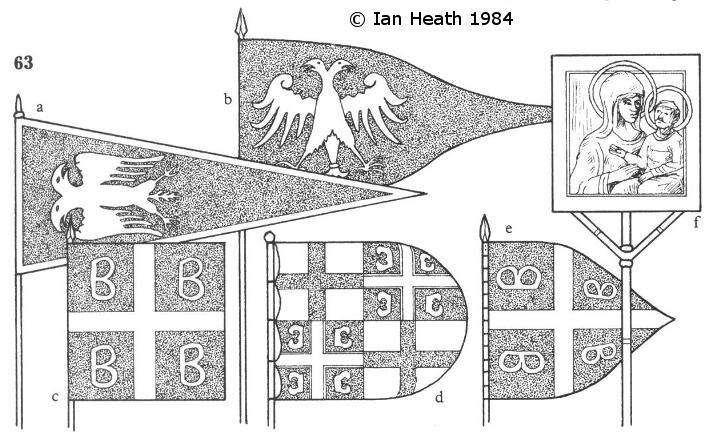
Join Amazon Prime - Watch Thousands of Movies & TV Shows Anytime - Start Free Trial Now
BYZANTINE FLAGS
An extract from Armies of the Middle Ages, Volume 2by Ian Heath



63. BYZANTINE FLAGS
63a comes from a bronze relief of c. 1445 on the doors of St Peter’s in Rome depicting a Byzantine galley bringing John VIII to Italy. Possibly it was purple, with the eagle in gold, but most sources depict the field of such flags as red. The eagle device was in use by the Byzantine Emperors at least as early as the 7th century, but Theodore II (1254-58) was the first to officially adopt the double-headed eagle emblem, which represented the dual nature of the traditional Empire with lands in both the East and the West. The Grand Komnenoi, emperors of Trebizond, adopted instead a single-headed eagle, though interestingly 63b, shown flying over Trebizond in Italian maps of 1320/1, has the eagle double-headed; the flag is red, with the eagle in gold.
63e is from a 13th century edition of Villehardouin’s ‘La Conquete de Constantinople’, similar red and gold or yellow flags being found in a large number of 14th century sources, 63c depicting another example of c. 1390. A modern authority has suggested that the sideways or upright ‘B’ symbols were originally crescents but were variously interpreted as broken chain links, steles or the Greek initial letters for the Palaeologian dynasty’s motto ‘king of kings, ruling over kings’, this flag indeed being that of the Palaeologi. As a result of intermarriage the same device also occurs in 15th century Serbian coats-of-arms.
63d, from the 14th century ‘Conoscimiento de todos los Reinos’, shows a variant of the above, with the Palaeologi arms (here with the cross and ‘B’ devices edged in green) quartered with a red cross on white.
63f is an icon, from the Moldavian fresco of the siege of Constantinople mentioned under figure55[56]. It is probably the famous ‘Lady of Blachernae’, described in 1204 as ‘all of gold and charged with precious stones’. In the fresco it is gold with Mary in red and Christ in orange, both with natural faces and silver halos, within a narrow inline box in red.